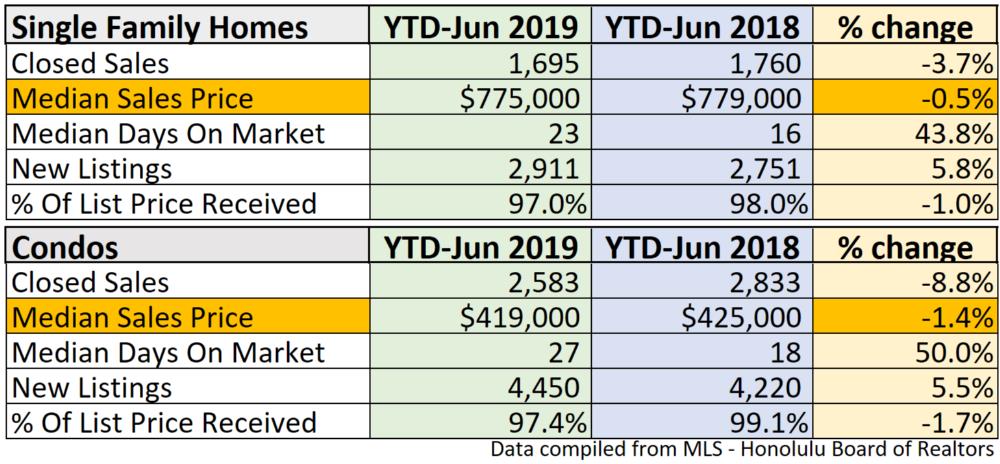— During a recent TPI interview with the legendary value investor Bill Miller, several important concepts were discussed that Bill applies as helpful tools when making financial decisions. I enjoyed the interview and decided to share one of his concepts on how it could apply to invest in Hawaii real estate:
- Differentiating between Cyclical vs. Secular trends
Before we explore this concept, let’s first compare the beginning of 2019 with today, 2019 mid-year.
Where are we today?
The US enjoys the longest economic expansion in history with slow and steady growth, record low unemployment, continuing wage growth, strong corporate earnings, and benign inflation just below 2%.
The stock market just reached a new record high.
During his recent address to Congress, Fed chair Jerome Powell hinted at possibly cutting the fed funds rate at the end of July. He confirmed the Fed’s commitment to “act as appropriate” to sustain the current expansion.
These are all positive developments for a healthy economy.
Today, July 2019, the typical ‘wall of worries‘ includes: Brexit, Iran, North Korea, trade tariffs, and raising the debt ceiling, ..again.
Powell explained, “potential risks include slowing business investment, uncertainty about global economic activity, and trade tensions.”
In the meantime, Hawaii’s tourism remains on track for another record year.
Contrary to some doomsday predictions of the possible impact of Bill 89, Honolulu’s New Short-Term Rental Rules, we believe Oahu’s economy will be fine. The net result will hardly show as a blip on the long-term chart.
Here we analyze Oahu’s real estate resale numbers by comparing the last 6 months, 1st half of 2019, with the 1st half of 2018. To spot a trend, one month of data would be insufficient because the sample size would be too small.
Moving sideways!
Demand, as defined by ‘Closed Sales,’ decreased by -3.7% (homes) and -8.8% (condos).
Supply, as defined by ‘New Listings,’ increased by 5% (homes) and 5.5% (condos).
‘Median Sales Prices’ decreased by -0.5% (homes) and -1.4% (condos).

The following ‘Closed Sales’ graph reveals a distinct seasonal zig-zag pattern of many sales in the summer and few sales in the winter.
Note that the seasonal highs and the seasonal lows in the number of closed sales have been declining for both homes and condos during the last 18+ months.

The median sales price more or less gyrated sideways for the last year.

So far, the long-term ‘uptrend channel’ for the median sales price that started in 2009 for homes and in 2011 for condos has remained intact. The trajectory of the channel could be leveling off soon.
Six months ago, few would have predicted that 30-year fixed mortgage rates would drop to a surprisingly low 3.75%, a record low rate we haven’t seen since November 2016!

Only three times since 1971 have we experienced 30-year mortgage rates at or below today’s level: May 2012 – May 2013, Jan – April 2015, and Feb – Nov 2016.
This only happened for 27 months out of the last 580. In other words, during all of the last 48+ years, at any given month you would have had only a 4.6% slim chance to secure a 30-year mortgage rate at or below 3.75%. – That is a rare opportunity.
Whether you know it or not, most of us pay about 30% in income taxes. In the US, you get to deduct your mortgage interest on your federal tax return for mortgage balances up to $750K on your principal residence.
The nominal mortgage interest rate that you pay after taxes is 2.625% (3.75 – 30%). At a 2% inflation rate, the real interest you pay on your mortgage is a vanishing low 0.625% (2.625 -2). – That is as close to borrowing free money as you could possibly get.
The borrowing cost (mortgage interest rate) is only one factor of affordability. In mid 2019, it is the favorable combination of three factors, 1) slightly lower median sales prices, 2) lower interest rates, and c) increasing wages, that has improved Oahu’s housing affordability.
Median sales prices may not move higher anytime soon until we either see a) an increase in demand (closed sales) and or b) a decrease in inventory.
What’s new for the 2nd half of 2019?
We see an increased probability for Oahu’s median sales prices to remain flat through the rest of 2019.
Since 1985, Oahu’s median sales prices have been higher year over year 72.7% of the time for single-family homes. Condos have been higher 66.6% of the time.
That means historically you have roughly a 70% chance that Oahu’s median home or condo sales prices increase in any given year. There is only a 30% chance that median sales prices stay flat or move down.
Timing the market and overcoming fear
In his book ‘Mastering The Market Cycle’ Howard Marx concludes, “it is virtually impossible to time cycles with any degree of accuracy. However, what you can tell is when things reach an extreme. We can tell if prices are extremely overpriced vs. extremely underpriced relative to history or other comparable metrics.”
In case you wondered, today’s Oahu real estate market is neither extremely overpriced nor extremely underpriced, at least not relative to history or other relevant comparable metrics.
Regardless if Oahu real estate prices move up or stay flat, you will need to be comfortable with the current market environment at the time when you want to make a move.
In the book “Buddha’s Brain” the author Rick Hanson argues that our human brains are wired to avoid harm. That’s how our ancestors evolved. Those who avoided snakes and approached banana trees for food had a better chance of survival and pass on their genes to the next generation. Negative memories are preferentially stored over positive memories to hopefully avoid snakes in the future.
But what used to be a practical survival skill for our early ancestors might be holding us back in today’s modern world. Once we realize that our brain overemphasizes risk over the potential for reward, we can use this knowledge, change our thinking, and overcome our fears.
Some buyers are still fearful of buying instead of recognizing the current market as an opportunity. The last time prices were temporarily flat was 2011 for condos, and 2009 for single-family homes. For some buyers, the fear today is comparable to 2009 and 2011, and all other years since then, even when the market was moving up.
In other words, regardless of what the market does, some continue to be afraid.
Ask yourself whether the true reason for the fear that is holding you back is an imagination, or if it is based on real observable evidence.

That brings us back to how we started this article with the typical ‘wall of worries’ and how Bill Miller applies the following concept to analyze markets:
Differentiating between Cyclical vs. Secular trends
Cyclical trends are temporary and fleeting. They include interest rate fluctuations, Fed speak, Trump tweets, trade war talks, and even recessions.
Secular trends won’t resolve anytime soon and could be even permanent and irreversible. They include the growth of digital over analog and the growth of electric cars over gasoline-powered cars. Blockbuster is gone for good, and no, we won’t go back to candlelight and horse carriages. You get the point.
Peter Lynch said, “more money has been lost worrying about recessions or preparing for recessions than is lost in the recessions themselves.”
Instead of worrying, understand the difference and assess the impact of cyclical trends vs. secular trends. For investment decisions, you would want to avoid secular declines and be invested in secular uptrends.
In applying this concept to Oahu real estate, here are some prevailing trends and underlying dynamics to consider:
- Supply of island land to develop is forever limited. Governmental red-tape limits new construction. Building costs are elevated due to high shipping costs.
- Demand for Hawaii real estate is seemingly endless and only limited by affordability. Hawaii real estate is still increasing in popularity as a global commodity, desired by many coming from all corners of the world.
- Hawaii maintains its position as a happy peaceful tropical paradise, while many places in the world appear to be getting crazier. Recently, Hawaii was found to be the happiest state in the nation, ..again.
See related article: Quality Of Life & The Finest Weather On The Entire Planet
As long as these favorable secular trends continue, Hawaii real estate is poised to remain a solid long-term investment.
________________
Conclusion
Unless you are fortunate to be able to crash for free on the couch in your parent’s basement, you either rent or you own your home.
Your choices in life are a) to maintain the status quo and continue with your current living setup, couch crashing, renting, or owning, or b) you make a change. Only you know which is the best option for you today and long-term.
We are strong proponents of owning your home as well as owning a sensible portfolio of rental properties.
Accurately timing the market is impossible. Instead, the best time to buy is:
- when you are ready emotionally, financially and otherwise,
- when you are committed to living in the same neighborhood for at least 3+ years, and
- when you find a suitable home you want to buy.
We are here to help, ready when you want to make a move.
________________
What do you think Oahu real estate prices will do in the next 6 months?
We love to hear from you.
Reciprocate Aloha! –‘Like’, ‘Share’, and ‘Comment’ below.
~ Mahalo & Aloha
